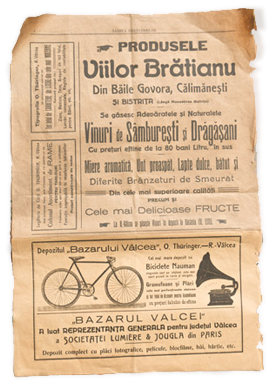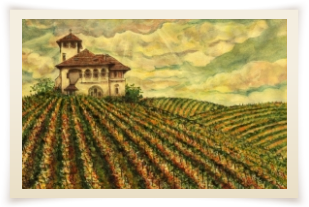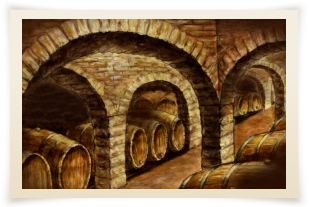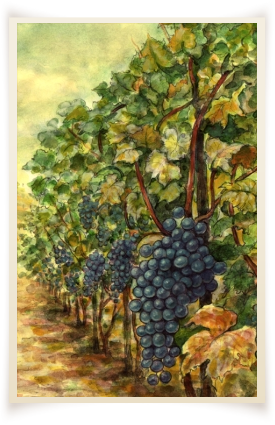
It goes without saying that only a miracle could bring such a blessed place as Samburesti is into this world. Protected against the threats of different times by the Carpathians’ impregnable walls and the guardian River Olt, prostrate, laying before their feet, Samburesti softly stretches over a marvellous fertile land.
It is obvious that this land has been inhabited by goodmen since ancient times, its name itself tells us that priceless orchards used to grow here.
Samburesti gloriously went down in history. Breviaries mentioned its name four hundred years ago when it was found in the possession of Theodosie Rudeanu, a great boyar, logothete, historian, diplomat and strategist, the right hand of Mihai Viteazul. Breviaries also tell us that wine was produced here even then, describing the subtleties of the cupbearer position in 1638.
Over the years, the land had notable owners: the nephew of Dan Danilovici, the Lord High Treasurer of Matei Basarab, then Constantin Brancoveanu’s son-in-law and, around 1800, it became the property of the Bratianus.
But an era was needed for Samburesti to become a legend. The “great accomplishments” era post 1945, full of with shortcomings and scarcity, turned each and every bottle of Samburesti wine into a real reward.

The name of Samburesti is clearly related to that of Samburul hill, which is still cultivated with stone fruit trees: plums, as it was four hundred years ago.
The village of Samburesti has existed since the 16th century, when it was in the possession of the Rudeanus, a family that gave the Romanian Country a whole series of high dignitaries, including Theodosie Rudeanu, the High Logothete and historian of Mihai Viteazul, rightfully called by Bogdan Petriceicu-Hasdeu “the most profound statesman of the Romanian boyars at the time.” In 1521, the Rudeanus owned 36 villages, including Samburesti.
From a documentary point of view, Samburesti was mentioned during the reign of Mihai Viteazul (1597-1598), when it is given by “royal order” to his well-known captain Val Armas Marco as a reward for his courage in the fight against the Turks and having successfully defended the town of Giurgiu, as a Governor.
It seems that Mihai Viteazul was born in the area, somewhere in the Commune of Dragoesti (Em. Kretulescu, “The Family of Mihai Viteazul”, “Revue for History, Archaeology and Philology”, 1986, page 184).
In 1611, Armas Marco Danovici, together with his wife Rada, founded the Samburesti church. Above the entrance, one can still see an inscription that reads: “This church was built by Val Armas Marco in 1611, as mentioned on an icon found in a grave”. In the village, the ruins of Marco’s palace are still visible, its walls being 2-meter thick. It is said that, during its construction, passers-by were stopped and put to work for 2 days, as there was a lack of labour. That’s how the palace was erected. It counted 24 rooms, they say.
On the 1st of August 1638, the rule of Marco Danovici, High Cupbearer and Provost Marshal, founder of the Samburesti monastery and nephew of Dan Danilovici, an enemy of Mihai Viteazul, officially commences as noted in the village records. Danovici pays Vlad Rudeanu the enormous amount of 400 ducats.
 On the 30th of May 1754, Constantin Cretulescu, ex-High Sword Bearer, son of Iordache Cretulescu, Constantin Brancoveanu’s son-in-law sells Samburesti manor which he inherited from his father. Later on, the owner will be Stefan Balota, ex-High Lord Steward, one of the founders of Curtea de Arges Monastery, who, besides this land, also owned a “stone church with a cellar and an orchard”, according to the sale deed. This proves that wine and fruit growing were already well-known in the area.
On the 30th of May 1754, Constantin Cretulescu, ex-High Sword Bearer, son of Iordache Cretulescu, Constantin Brancoveanu’s son-in-law sells Samburesti manor which he inherited from his father. Later on, the owner will be Stefan Balota, ex-High Lord Steward, one of the founders of Curtea de Arges Monastery, who, besides this land, also owned a “stone church with a cellar and an orchard”, according to the sale deed. This proves that wine and fruit growing were already well-known in the area.
 In 1864, 195 dwellers of Samburesti received 615 ha of the lands owned by I.C. Bratianu, I. Ceausescu, St. Zaharescu and Gh. Viteleanu. The City Hall’s records at the time show that Samburesti area produced about 6000 decalitres of plum brandy and 6500 decalitres of wine. They still respected the tradition of Marco Danovici, who, having “large vineyards”, brought “the wine directly into the cellars of his palace through a network of pipes, still existing underground.”
In 1864, 195 dwellers of Samburesti received 615 ha of the lands owned by I.C. Bratianu, I. Ceausescu, St. Zaharescu and Gh. Viteleanu. The City Hall’s records at the time show that Samburesti area produced about 6000 decalitres of plum brandy and 6500 decalitres of wine. They still respected the tradition of Marco Danovici, who, having “large vineyards”, brought “the wine directly into the cellars of his palace through a network of pipes, still existing underground.”
Vintila Bratianu hires August Joseph Ville, one of the most well-known oenologists in France.
August Joseph Ville (1860-1934) was born in France, on the 16th of May 1860, in Saint Jean de Verges. He graduated the Grand Ecole of Agriculture in Perpignan, then the Grand Ecole of Horticulture in Versailles (1884). For a short period of time, he worked as an engineer for different horticultural associations around Paris and as a university assistant at the Grand Ecole of Wine-Growing in Montpellier.
Starting in 1886, he worked in Florence (Italy) as a fruit-growing professor and he published a book on peach cultivation, rewarded with a silver medal by the Italian Science Academy. In 1893, he leaves France permanently as, on the Romanian Government’s request, the French State gives him the mission to help Romania recover vineyards destroyed by phylloxera. He brings Muscat Ottonel, Merlot and some other wine varieties into the country for the first time. He starts breeding and spreading them.
In 1897 he marries Smaranda Sandu from Pietroasa. They have three boys, all of them becoming agricultural engineers. He works in Pietroasa until 1906, when he leaves for Dragasani, the Commune of Mihaiesti, as he is hired by Vintila Bratianu to recover the vineyards on his lands in Florica, Dragasani and Samburesti. In 1912 he retires to Ramnicu Valcea and establishes a horticultural nursery. During World War I, he takes care of the army’s gardens around Iasi City. After the war, he comes back as a teacher to the Horticultural School in Ramnicu Valcea. As a reward for his activity, the Romanian State vests grants him the ownership of a 5 ha-property in him. In 1928 he retires, but he still works as chief gardener for the Episcopate of Ramnicu Valcea. He died on the 29th of June 1934 in Ramnicu Valcea.
 Gold medal at the Universal Exhibition of Paris on 12th of September 1926.
Gold medal at the Universal Exhibition of Paris on 12th of September 1926.
On the occasion of the apportionment of property in 1945 (a prelude to the collectivization to come), excluding the estates that entered the peasants’ possession, part of the lands became the property of the State and formed the AFSMs (Administration of State Farms and Machinery Parking).
In 1949, the collectivization turned the former property of Vintila Bratianu into G.A.S. Samburesti, the current owner of more than 70 ha of orchards, 40 ha of vineyards and 300 ha of woods.
From the red grapes the Bordeaux of Samburesti is made, called “The Power of the Bear”, and the white wines are mild and very tasty.
*Information kindly supplied by Mr. Ilie Macau, author of the thesis “Study on the Oenological Potential of the Samburesti Vineyard”, University of Agricultural Sciences, Bucharest, 1994, Chapter 1, “Historic Landmarks in the Development of Samburesti and Dobroteasa, Current Quarters of the Samburesti Vineyard”





